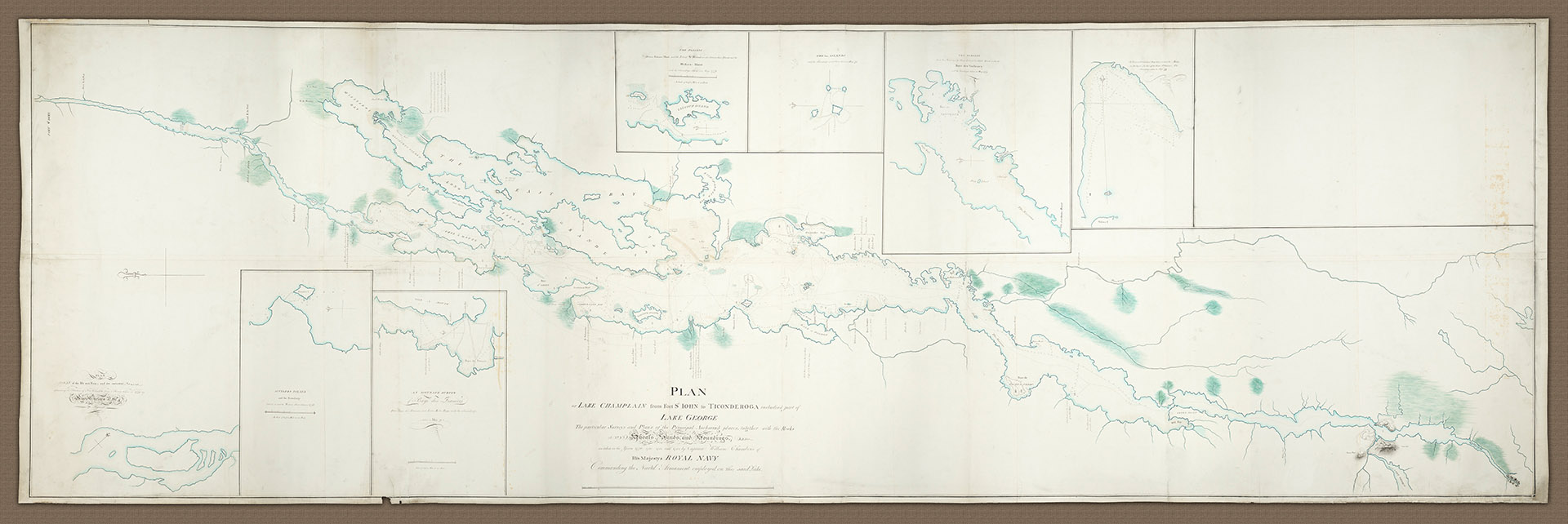
A213 - Lake Champlain from Fort St. John to Ticonderoga
This beautiful survey of lake Champlain by Captain William Chambers & others was completed after the British had taken full control of the lake late on into the Revolutionary war. As the theatre of war moved south so the British moved-in again in this important region. During this period the British suffered very little resistance from American forces in the region.
- 1779-1782
- Capt. William Chambers & others
- h42" x w132"
- L
As the theatre of war moved south so the British moved-in again in this important region. During this period the British suffered very little resistance from American forces in the region. During this time there were developments in the way the British organised their Lakes Navy. In 1778 a new naval service called the Provisional Marine was created, independent from the Admiralty. It was instigated by Sir Guy Carleton KB, governor of Canada and then developed by Sir Frederick Halimand KB, his successor. The service really found its feet when, in 1778, it was divided into three divisions: Lieutenant William Chambers, RN, commanded on Lake Champlain; Master and Commander James Andrews commanded on Lake Ontario; and Alexander Grant continued on the upper lakes.
Chambers was one of the rising-stars of the service and by 1782, he was appointed Senior Captain, reporting directly to the Governor himself, Sir Frederick Halimand KB. Chambers surveying work on Lake Champlain between 1779 and 1782 was exceptional and as can be seen from this beautiful manuscript, both detailed and beautifully presented. His command on the lake with the Royal Navy Fleet was not just about surveying however, he had many duties to perform patrolling the water.
By the end of the war in 1782 the Provisional Marine Service had rather lost direction and reductions in the number of officers employed in the Service being reduced from 468 to 20. Dockyard workers on the lake were reduced from 47 to just 12. Chambers himself went on to publish privately his own work in the much lauded 'Atlas of Lake Champlain' 1779-1780. In this book Chambers not only published charts but he provided a commentary of the surrounding countryside which gave the work the feel of a modern day cruising guide, as used by recreational boaters.
Chamber's use of insets around this chart to expand upon the harbors, bays, passages/channels and islands around the shore adds to the charm of the piece but intriguingly, one of the inset boxes at the top right of the survey remains empty as though the work was never finished. One inset survey (bottom left) is accredited to Major (Christopher) Carleton of the 29th Regiment. Carleton had, in 1778 led a hugely successful raid on parts of New York and Vermont passing through Lake Champlain from his base at Ile aux Noix (the subject of his survey inset), further North up the river from the Lake.
Lake George is not included, in its entirety, on the survey. The raid had seen the successful destruction of enough American supplies for 12,000 men for a 4-month campaign, including included, 47 houses, 48 barns, 1 saw mill and a grist mill, 28 stacks of wheat and 75 stacks of hay. In addition, over 80 head of cattle and 39 prisoners were captured and taken back to Quebec. The following year Carleton led further raids which went under the name of 'the burning of the valleys'.
Chambers dates the survey through 1779, 1780, 1781 and 1782.
- Lake Champlain from Fort St. John to Ticonderoga including Part of Lake George


